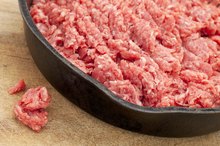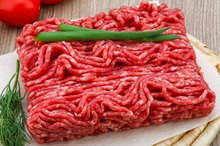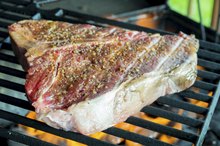What Nutrition Does Meat Have?
Meat, or animal flesh that is consumed as food, is composed of skeletal muscle and fat. Different animals have different body compositions, and therefore their meat varies in nutrient profile. For example, turkey is considerably leaner than beef, meaning it has much less fat, but it has about the same amount of protein per ounce. While the nutrient ratios in meat vary widely, all meat is made up of the same basic nutrients -- protein, fat, vitamins and minerals.
Protein
Proteins, the building blocks of life, are needed by your body to repair and build cells and are essential for normal growth and development, especially during childhood and pregnancy. Protein is made up of amino acids and is present in all animal sources, but meat contains more protein than other animal sources such as eggs and milk. Six ounces of steak contains about 42 g of protein, while one large egg contains only 6 g. MayoClinic.com recommends adults consume between 10 and 35 percent of their daily calories from protein, based on a 2,000-calorie diet, or between 50 and 175 g. Too much protein from meat in your diet can have adverse effects, including increased strain on your kidneys.
Fat
Gyro Meat Nutritional Information
Learn More
Meat can be classified into three different categories based on its fat content, according to MayoClinic.com. Lean meat is any meat that contains less than 3 g of fat and about 45 calories per serving. Medium-fat meat contains between 4 and 7 g of fat and 75 calories. High-fat meat contains 8 g or more and at least 100 calories. Fat is needed by your body to carry out normal bodily functions, such as hormone production. MayoClinic.com recommends a daily fat intake of around 20 to 35 percent of your total calories, or between 44 and 78 g of total fat based on a 2,000-calorie daily diet. Too much fat from meat can increase your cholesterol levels, increasing your risk for cardiovascular disease.
Vitamins and Minerals
In addition to the macronutrients such as protein and fat, meat contains micronutrients like vitamins and minerals. According to the British Meat Nutrition Education Service, red meat, that is, beef, pork and lamb, contains vitamins A, B, D and K as well as copper, chromium, folic acid, iron, magnesium, potassium, selenium and zinc. These vitamins and minerals have important roles in the body and have a wide variety of effects. Iron, for example, is needed to carry oxygen from your lungs to various body tissues.
Recommendations
Duck Fat and Cholesterol
Learn More
According to the federal government's MyPlate, which has replaced the food pyramid, the amount of meat you need depends on many factors, including age, sex and physical activity. However, people should follow some basic guidelines. Most adult men should eat between 5.5 and 6.5 oz. of meat daily, while adult women require slightly less, between 5 and 5.5 oz. daily. Adolescents and children require less meat, but it is still recommended they eat some meat every day. Talk with your doctor about how much meat you should be eating on a regular basis to keep your body healthy.
Related Articles
References
- "Nutrition for Health, Fitness, and Sport"; Melvin H. Williams; 2002
- MedlinePlus: Protein In Diet
- British Meat Nutrition Education: Nutrients Found in Red Meat
Writer Bio
Joe King began writing fitness and nutrition articles in 2001 for the "Journal of Hyperplasia Research" and Champion Nutrition. As a personal trainer, he has been helping clients reach their fitness goals for more than a decade. King holds a Bachelor of Science in kinesiology from California State University, Hayward, and a Master of Science in exercise physiology from California State University, East Bay.









